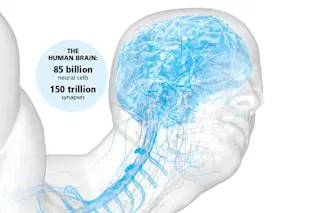“Sorry, I’m busy right now,” you tell a friend. That’s so true. For its size, your body is as busy as the galaxy.
Even when we’re resting and daydreaming, internal activity is nonstop. The brain, of course, is the crown jewel of our nervous system. It has 85 billion neural cells and 150 trillion synapses. These are its electrical connections, its possibilities. This figure is nearly a thousand times as great as the number of stars in the Milky Way.
The number of brain neurons is impressive. To count them at the rate of one a second would require 3,200 years. But the brain’s synapses, or electrical connections, are beyond belief. Those 150 trillion could be counted in 3 million years. And that’s still not the end of the matter. What’s relevant is how many ways each cell can connect with the others. For this we must use factorials. Let’s ...














